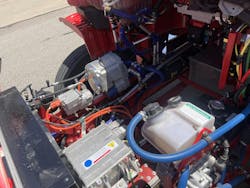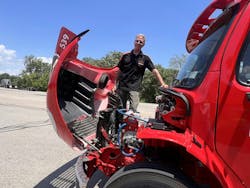Eaton and BAE collaborate on medium- and heavy-duty battery electric powertrain with a 4-speed transmission
MARSHALL, Michigan—Eaton, known for its transmissions, partnered with BAE, an electrified propulsion company that’s contributed thousands of electrified motors to the bus industry worldwide, to develop an integrated powertrain, complete with an electric motor and a 4-speed transmission.
The companies announced their success at ACT Expo in May but recently showcased it to fleet owners, OEMs, and media at Eaton’s proving grounds here.
This integration is significant for the trucking industry. But to fully understand why, we need to take a closer look at how EVs operate.
Currently, there is no battery electric vehicle on the road today with more than two gears. Gears aren’t required to operate a BEV. This is because electric motors produce consistent torque output at any RPM, which negates the need for gears that enable higher torque output at different RPMs in an internal combustion engine. To understand more simply, think of the operation of an electric golf cart.
See also: Fleets Explained: How are electric vehicles different?
Like golf carts, most battery electric cars have a single gear. There are currently only two BEV models with more than one gear, the Porsche Taycan and the Audi e-tron GT, which both have two. Porsche says the reason behind the two-gear Taycan is to ensure “high efficiency and power reserves even at very high speeds.” That second gear isn’t at all necessary, but does it offer its owner a bit more confidence in the luxury performance vehicle’s power? Likely.
While unnecessary for drivers of battery electric consumer vehicles, that power boost could come in handy for drivers of medium- and heavy-duty commercial vehicles that haul significant weight.
Volvo equipped its VNR, a Class 8 battery electric truck, with two gears. The Freightliner eCascadia also features two speeds. However, Tesla opted for a single gear in its Tesla Semi, albeit with three different motors powering the wheels. On the medium-duty side, Freightliner also equipped its eM2 with a 2-speed transmission. While these vehicles can meet some industry needs, Eaton and BAE have found the benefit of putting traditional transmissions back into BEVs—with some modifications, of course—and the whole system appears less complicated than BEVs with no transmission.
“Both [Eaton and BAE] realized there’s a benefit to having a multi-speed transmission in some, but not all, applications,” Justin Hopkins, product director, E-Powertrain, Eaton said. “When you are getting into some of these heavier applications where you need a strong startability for when it’s going up a high grade—20, 25, 30%—and you also need to operate the vehicle at 60-65 mph on the highway efficiently, having a multi-speed transmission better enables you to go to a smaller, lower-cost motor.”
The demonstration
The product of their collaboration powers a modified 2018 Freightliner M2 crew cab. The vehicle was stripped of its ICE powertrain that was replaced with an electric BAE Systems’ propulsion solution and an Eaton MD 4-speed EV transmission. The vehicle features Forsee Zen 77 Plus batteries and a Meritor rear axle with 3.9:1 ratio.
This Class 7 truck can accommodate a 33,000 GVWR and a payload capacity of more than 18,000 lb. It features 230 kWh of electrical energy storage and has an electronically limited speed of 70 mph. According to Eaton and BAE’s specs, it can start on a 21% grade from 0 mph when loaded (although during one test, it was nearly able to scale a 25% grade fully loaded). This powertrain is said to improve the acceleration rate from 0-20 by two times. And the best part, this powertrain only adds 1,400 lb. of curb weight compared to its ICE weight.
While the goal was to offer a higher power output for medium- and heavy-duty EVs, the two companies created an EV powertrain that appears significantly simpler than the system components of today’s EVs.
“We reduce, in our comparison to most Gen 1, about 100 parts and 50% weight reduction,” Tom Webb, director of business development and strategy, BAE Systems, said.
Upon looking at the demonstration vehicle, it’s true—the amount of bright orange high-voltage wiring was quite minimal compared to the amount running below current trucks today. And under the hood, there’s even room for someone to stand.
The BAE solution achieves this simplification through a “modular” solution that eliminates component boxes, multiple high-voltage cables, cooling lines, coolant fittings, component mounts, fasteners, and more.
“We’re offering that better combination of vehicle performance and cost with the smaller motor and transmission,” Hopkins said.
While this integration has only recently been released to the public, this innovative, heavy-duty trucking electrified solution is something FleetOwner will keep on its radar.
About the Author
Jade Brasher
Senior Editor Jade Brasher has covered vocational trucking and fleets since 2018. A graduate of The University of Alabama with a degree in journalism, Jade enjoys telling stories about the people behind the wheel and the intricate processes of the ever-evolving trucking industry.



